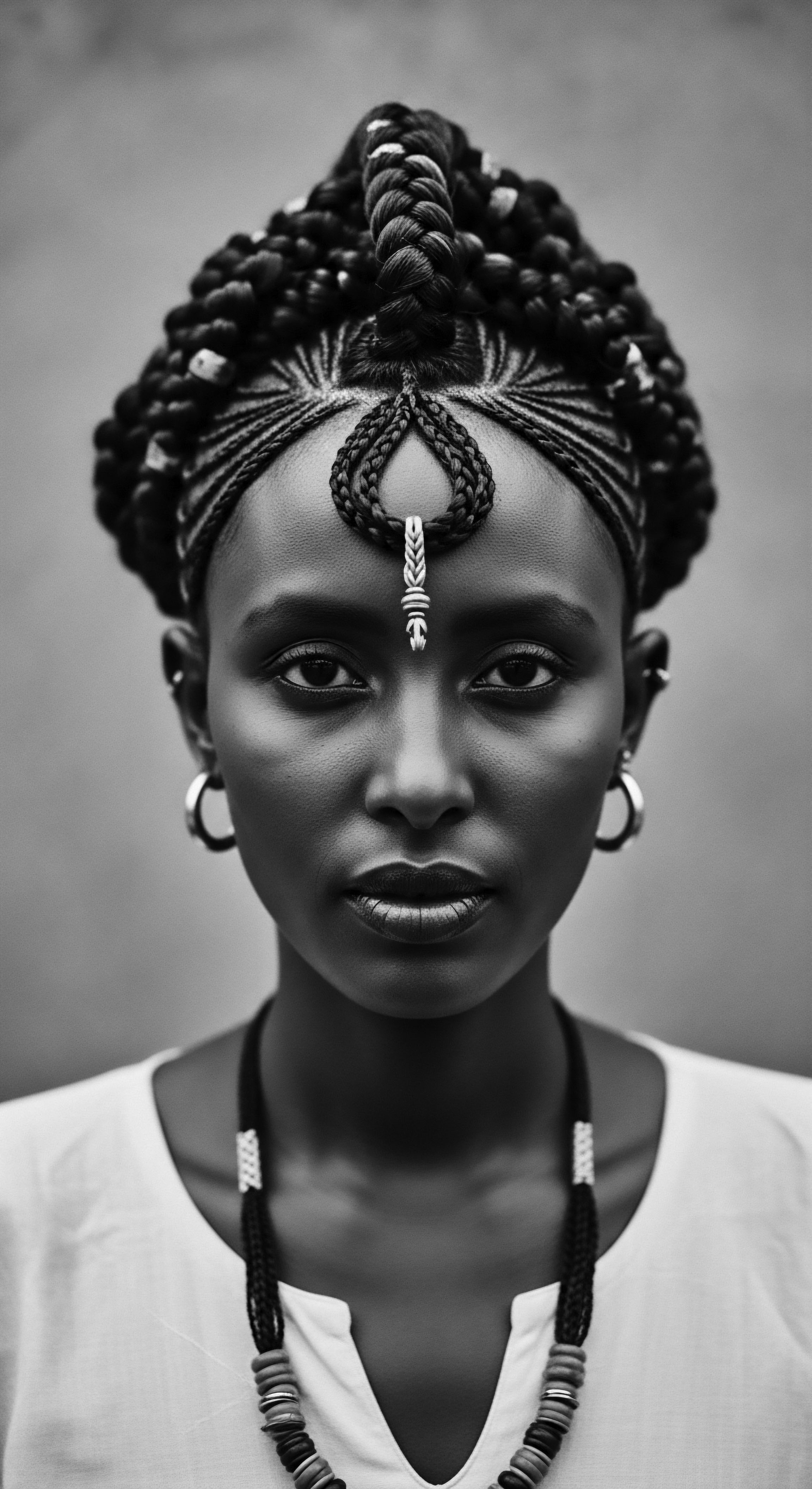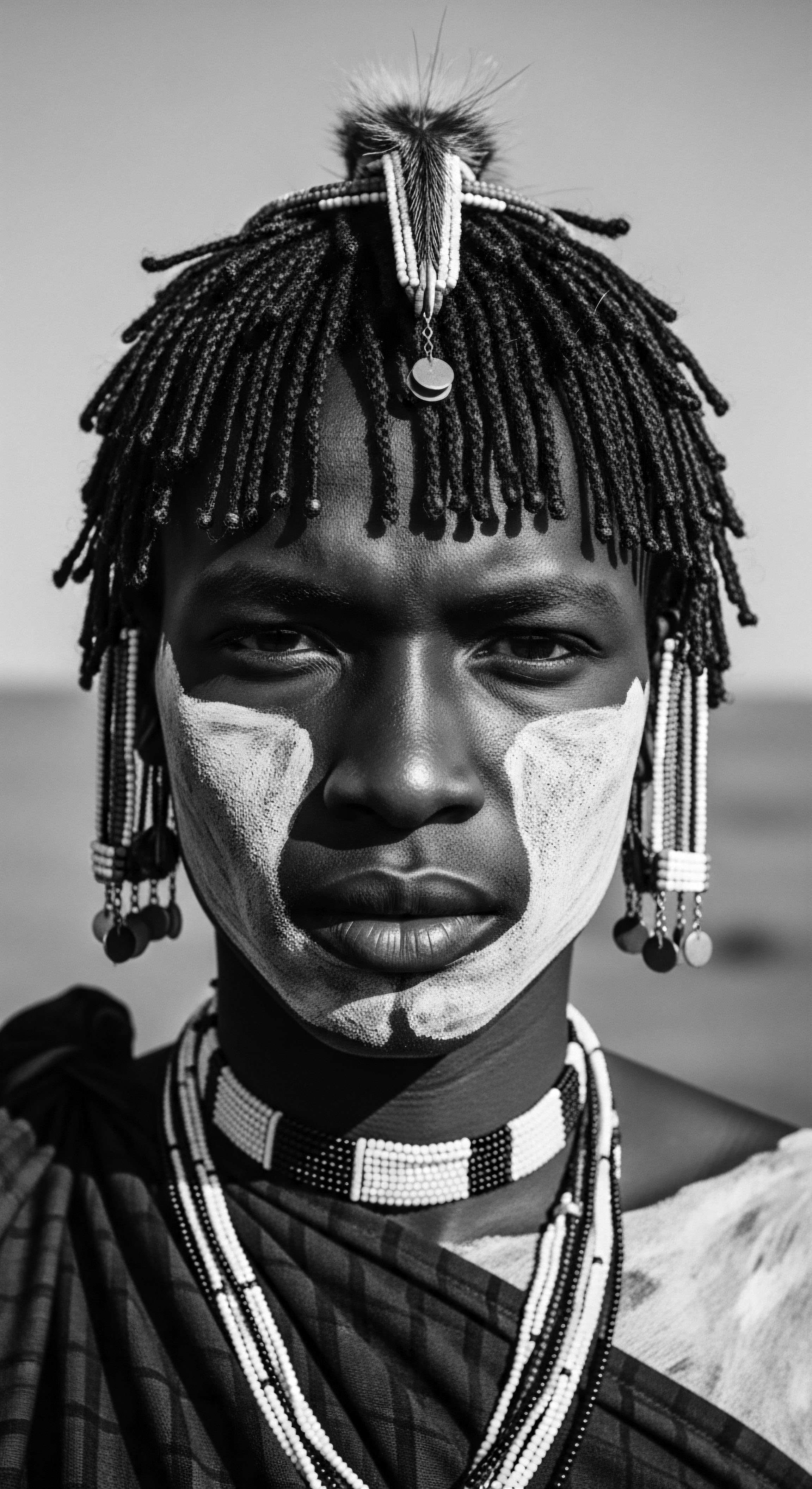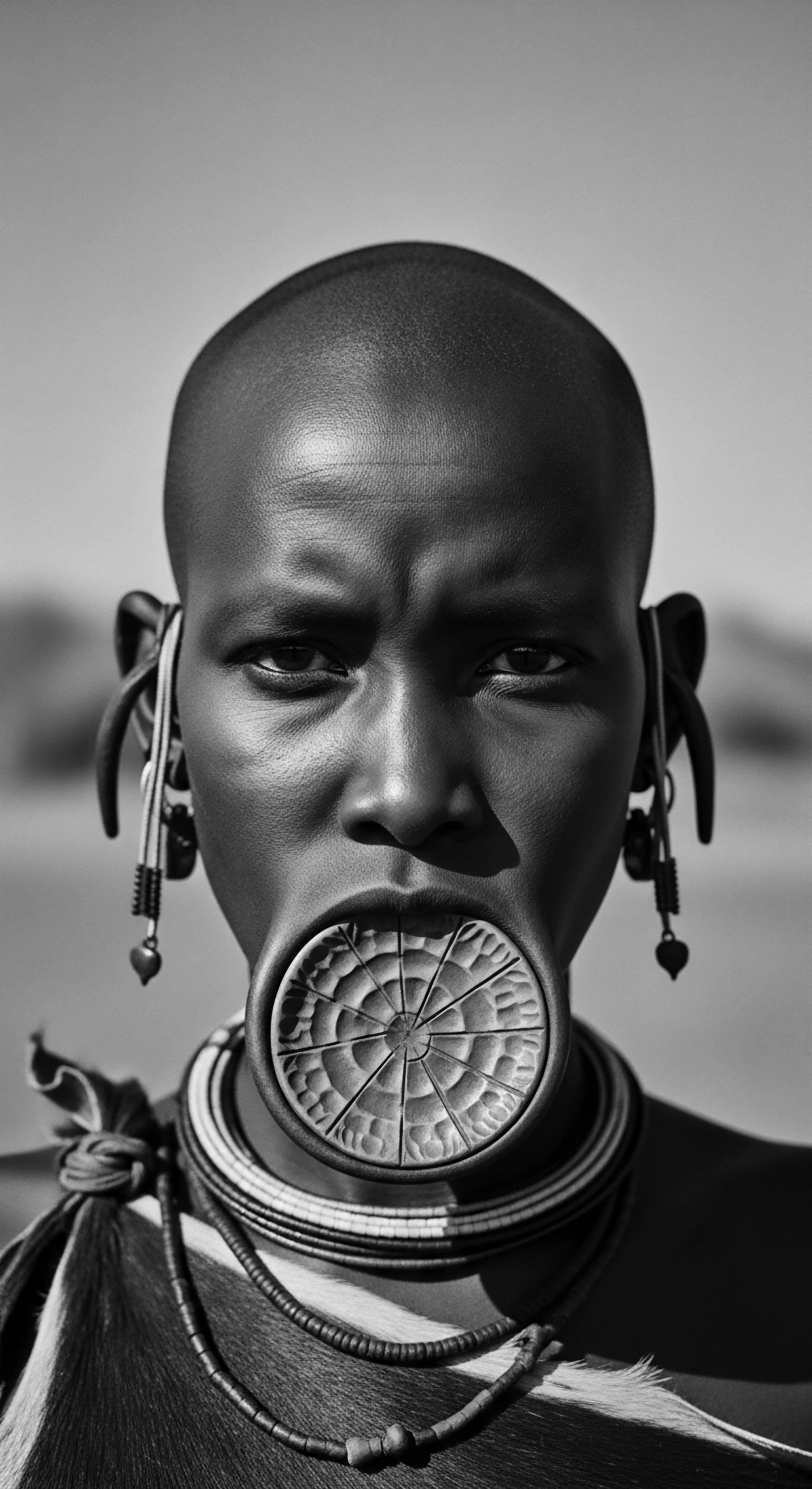
Roots
When we speak of hair, particularly the magnificent coils and kinks that crown so many, we often speak of an inheritance. This isn’t merely about genetic codes; it’s about the deep memory carried within each strand, a living archive of generations past. For those with textured hair, the story of adornment and care is a profound narrative, one deeply intertwined with cultural identity and expressions of self.
Within this ancestral dialogue, Henna emerges not just as a dye, but as a silent, powerful custodian of tradition. Its journey from elemental botanical to cherished ritual speaks volumes about connection, community, and the timeless pursuit of wellness for our hair.
The very structure of textured hair – its ellipticity, the twists and turns along the shaft, the distinct arrangement of disulfide bonds – renders it unique. These biological distinctions, honed over millennia, shaped how our ancestors interacted with their hair and, by extension, with ingredients like henna. From the earliest documented applications in ancient Egypt and the Fertile Crescent, henna’s reddish-brown embrace offered more than mere pigmentation. It contributed to the hair’s integrity, providing a subtle strengthening effect that was intuitively understood long before microscopes revealed keratin structures.
The plant, Lawsonia inermis, a thorny shrub thriving in arid climates, became a beacon of possibility, its leaves holding the secrets of its potent dye molecule, lawsone. This compound, when released through an acidic liquid and applied to hair, bonds with the keratin, forming a robust and lasting stain. For ancestral communities, this interaction wasn’t a chemical reaction to be analyzed; it was a phenomenon, a gift from the earth, capable of transforming and safeguarding.
Henna, a botanical messenger, carries the ancestral wisdom of hair adornment and structural care, speaking to the deep historical relationship between plants and textured hair well-being.
Consider the nomenclature used to describe textured hair throughout history. While modern systems attempt to categorize curl patterns, ancestral cultures often employed descriptors rooted in sensory experience, societal roles, or even spiritual significance. In many West African societies, for example, hair was rarely seen as simply “hair.” It could signify status, age, marital state, or even tribe. The application of substances like henna, often mixed with other plant materials or oils, was part of a larger symbolic language.
This practice wasn’t just about aesthetics; it spoke to protection, spiritual cleanliness, and tribal affiliation. The very act of preparing the henna, grinding the dried leaves into a fine powder, mixing it with specific liquids like black tea or lemon juice to release the dye, was itself a ritual, a continuation of ancestral practice, often accompanied by storytelling and song.

How Did Ancient Societies Perceive Hair and Its Adornment?
Ancient civilizations across Africa, the Middle East, and South Asia viewed hair with immense reverence. In pre-colonial West Africa, distinct hairstyles, sometimes augmented with henna, served as powerful identifiers. For instance, among the Yoruba people, elaborate braiding patterns, often adorned with cowrie shells or beads, were not just decorative; they conveyed messages about one’s lineage, social standing, and even religious beliefs (Mbiti, 1969).
The conditioning and strengthening properties of henna would have been especially valued for maintaining these complex, labor-intensive styles, contributing to the hair’s durability and luster under harsh environmental conditions. The hair, therefore, was a living canvas, reflecting an individual’s journey and community ties, and henna served as a foundational medium for this expression.
The historical lexicon surrounding hair care in many of these cultures points to a deep, experiential understanding of hair’s needs. Terms often described not just the hair type but its overall health, its potential for styling, and its symbolic weight. When we consider the hair growth cycles through this ancestral lens, it becomes apparent that practices were developed to support each phase. The cyclical nature of hair, its shedding and regrowth, mirrored the rhythms of life and agricultural cycles.
Henna, with its long-lasting adhesion to the keratin, supported the hair throughout its growth phase, shielding it from external aggressors and minimizing breakage, a practical benefit keenly observed and applied by generations. This pragmatic understanding, combined with ceremonial significance, cemented henna’s place in the hair care traditions of diverse cultures.
| Historical Perspective (Pre-Modern Science) Hair's strength and luster were linked to overall vitality and divine favor. |
| Contemporary Understanding (Rooted in Ancestral Practice) Henna's lawsone molecule bonds with keratin, strengthening the hair shaft and imparting shine. |
| Historical Perspective (Pre-Modern Science) Hair adornment marked social status, tribal belonging, and life stages. |
| Contemporary Understanding (Rooted in Ancestral Practice) Henna acted as a foundational element in protective styles, aiding in their longevity and aesthetic. |
| Historical Perspective (Pre-Modern Science) Natural ingredients applied for perceived benefits and ceremonial purity. |
| Contemporary Understanding (Rooted in Ancestral Practice) Modern science validates the antioxidant and conditioning properties of henna, confirming ancestral observations. |
| Historical Perspective (Pre-Modern Science) The enduring utility of henna for textured hair spans millennia, reflecting an ancestral knowing of its inherent benefits. |

Ritual
The act of hair care, particularly within communities shaped by African and diasporic experiences, has always transcended mere hygiene; it is a ritual, a language spoken through touch, a passing down of wisdom across generations. Henna, in this sacred context, has served as a tangible connection to ancestral practices, its application a tender thread binding past to present. The tradition of adorning hair with henna speaks to a legacy of beauty, resilience, and identity that runs as deep as our roots.
Throughout various African and South Asian cultures, henna’s role in hair styling was far more comprehensive than simply coloring. It often served as a natural conditioning agent, a sealant, and even a mild detangler, benefits keenly appreciated for hair that naturally coils and kinks. For centuries, before the advent of chemical relaxers, communities relied on natural compounds to manage, style, and protect their diverse hair textures. Henna became a cornerstone in many of these routines.
Its ability to subtly coat the hair shaft provided a layer of protection against environmental stressors, particularly relevant in regions with intense sun or arid winds. This protective quality supported the longevity of intricate, labor-intensive styles, which themselves often served as declarations of identity or markers of significant life events.

What Cultural Styling Traditions Honored Henna for Textured Hair?
In many communities, the preparations for grand occasions – weddings, births, coming-of-age ceremonies – invariably involved elaborate hair rituals, frequently incorporating henna. Among the women of the Fulani people of West Africa, for instance, hair care is an extensive and communal affair. Henna, along with shea butter and specific herbs, traditionally comprised part of the nourishing treatments applied to hair, contributing to its health and the sheen of their distinctive braided styles (Eicher, 1995).
These styles were not just aesthetic; they were practical protective measures, safeguarding the hair from the elements and minimizing breakage, ensuring the hair remained strong and vibrant through daily life and arduous journeys. The collective experience of hair dressing, often taking hours, solidified communal bonds and preserved ancestral knowledge.
The use of henna extended to shaping hair, often in combination with other natural elements. Consider the traditional practice of using clay mixtures or specific plant mucilages alongside henna to create temporary hold or to enhance curl definition. This speaks to a sophisticated, empirical understanding of material properties long before modern cosmetic chemistry. These historical styling techniques, far from being simplistic, involved a deep knowledge of plant compounds and their interaction with hair structure, a knowledge passed orally and through demonstration.
Henna’s enduring appeal in styling rituals lies in its multi-functional gift ❉ a shield, a conditioner, and a chromatic declaration of identity.
The migration of peoples, whether through forced displacement or voluntary movement, meant the migration of these hair traditions. In the diaspora, particularly among Black and mixed-race communities, ancestral hair practices became powerful assertions of cultural continuity and resistance against imposed beauty standards. Henna, though sometimes adapted or fused with new ingredients, remained a link to the homeland, a way to maintain traditional beauty aesthetics and hair health in new environments.
- Sudanese Bridal Hair Rituals ❉ Henna is central to Sudanese wedding preparations, applied not only to hands and feet but also to the hair of the bride. This is believed to cleanse, protect, and impart blessings, ensuring the bride’s hair is radiant and strong for her new journey.
- Indian Wedding Traditions ❉ Beyond intricate skin designs, henna is often applied to the hair of brides and grooms, symbolizing fertility, good fortune, and a healthy life together, contributing to the hair’s luster and richness of tone.
- North African Hair Masques ❉ In Morocco and Algeria, henna is frequently blended with other herbs such as argan oil or rhassoul clay, forming deep conditioning masques that purify the scalp, strengthen strands, and add depth to hair color, a tradition passed through matriarchal lines.
While modern hair products offer a plethora of chemical solutions for coloring and styling, the ancestral wisdom embedded in henna use offers a timeless alternative. It reminds us that authentic beauty often lies in harmony with nature, in the thoughtful application of ingredients that have sustained our heritage for centuries.

Relay
The journey of textured hair care, from ancient remedies to contemporary routines, is a relay race of wisdom, with each generation passing on the torch of understanding. Central to this enduring legacy is the concept of holistic wellness, where the care of hair is not isolated but intimately connected to the body’s entire ecosystem, deeply rooted in ancestral philosophies. Henna, in this framework, transcends a mere cosmetic application; it becomes a vital component in a comprehensive approach to well-being, its heritage extending into the very core of problem-solving for textured hair.
For ancestral communities, hair health was a direct reflection of internal balance. Nutrition, spiritual peace, and environmental harmony were all seen as contributing factors to vibrant strands. Henna was often integrated into regimens designed to address various hair concerns, from thinning to lack of luster, all from a perspective that sought to restore natural equilibrium. Its anti-fungal and antibacterial properties, perhaps intuitively observed rather than scientifically quantified, likely played a role in maintaining scalp health, a foundation for healthy hair growth.
The meticulous preparation of henna mixtures, sometimes infused with other herbs like amla or shikakai, speaks to a sophisticated, empirically developed understanding of how different botanicals interacted to create synergistic benefits. This was, in essence, ancestral hair chemistry.

How Does Ancestral Wisdom Inform Modern Textured Hair Regimens?
The wisdom of our forebears, often preserved in oral traditions and generational practices, continues to provide blueprints for building personalized textured hair regimens today. The emphasis on gentle cleansing, deep conditioning, and protective styling—all cornerstones of effective modern textured hair care—finds echoes in historical practices that frequently involved plant-based washes and protective wraps. Henna, as a coating agent, helped fortify the hair cuticle, reducing porosity and rendering the hair less susceptible to environmental damage and breakage. This protective function was particularly crucial for textured hair, which, due to its unique structure, can be more prone to dryness and fragility.
Holistic hair care, a beacon from ancestral wisdom, views henna not as an isolated product, but as an integral part of a balanced regimen that nourishes both strand and spirit.
The nighttime sanctuary, the ritual of sleep protection, also carries a deep heritage. Our ancestors, recognizing the vulnerability of hair during rest, likely employed various methods to preserve their elaborate styles and prevent tangling. While modern bonnets and silk scarves are contemporary manifestations, the underlying principle – protecting hair while sleeping – is ancient.
Henna-treated hair, being stronger and often smoother, would have benefited immensely from such protection, extending the life of styles and reducing the need for daily manipulation. This attention to detail, this proactive approach to preservation, speaks volumes about the value placed on hair as a cultural and personal asset.
When considering specific ingredient deep dives for textured hair needs, henna holds a place of honor. Lawsone, the molecule responsible for its color, binds with the keratin in the hair, forming a layer that strengthens the strand from within. This is not simply a superficial coating; it is a structural reinforcement that improves the hair’s elasticity and resistance to breakage.
- Lawsone’s Keratin Bond ❉ The active dye molecule in henna, lawsone, forms a direct bond with the protein Keratin in hair, thereby strengthening the hair shaft and reducing breakage over time.
- Scalp Health Promotion ❉ Henna possesses natural anti-fungal and antibacterial properties, traditionally employed to maintain a clean and healthy scalp environment, reducing concerns like dandruff or irritation.
- Natural UV Protection ❉ The pigments within henna provide a degree of natural protection against ultraviolet radiation, historically shielding hair from sun damage in equatorial regions.
Addressing textured hair problems from a heritage perspective means looking beyond quick fixes to systemic solutions that respect the hair’s natural inclinations. For dryness, ancestral solutions often involved deep conditioning with plant oils and butter, complemented by henna’s sealing properties. For breakage, the emphasis was on minimal manipulation and strengthening treatments, of which henna was a prime example.
The continued use of henna today by those seeking natural solutions for strength and color stands as a powerful testament to the enduring authority of ancestral wisdom. The scientific lens now helps us understand the “why” behind the traditional “what,” validating generations of practical knowledge.

Reflection
In the vibrant continuum of textured hair heritage, henna stands as a silent sentinel, a botanical echo from ancient times that still whispers lessons of beauty, connection, and resilience into our modern ears. Its journey, from the elemental earth to the ceremonial crowning of queens and everyday protection of strands, is a testament to an enduring wisdom passed through touch, through scent, through shared ritual. This deep connection to cultural identity, particularly within Black and mixed-race communities, speaks to hair not as an isolated entity, but as a living extension of self, history, and lineage.
The soul of a strand, as we often reflect, carries not just proteins and pigments, but stories—stories of survival, of celebration, of the meticulous care that defined generations. Henna has been a loyal companion in these narratives, offering its protective embrace, its earthy hues, and its subtle strength to those who sought solace and expression in their hair. Its continued use today is not a nostalgic retreat into the past; it is a conscious reclaiming of agency, a recognition of the potency residing in traditional practices, and a profound declaration of reverence for our ancestral legacy.
It beckons us to look beyond fleeting trends, to listen to the enduring rhythm of heritage, and to find radiance in the wisdom that has always been ours. The legacy of henna, intertwining with the very fibers of textured hair, remains a luminous guide for our ongoing journey of self-discovery and holistic well-being.

References
- Eicher, J. B. (1995). Dress and Ethnicity ❉ Change Across Space and Time. Berg Publishers.
- Mbiti, J. S. (1969). African Religions and Philosophy. Heinemann.
- Robins, A. G. (1990). Hair Care ❉ Chemistry and Formulations. Marcel Dekker.
- Saraf, S. & Saraf, S. (2010). Herbal Cosmetics ❉ A Practical Handbook. PharmaMed Press.
- Westmoreland, L. L. (2012). The Science of Black Hair ❉ A Comprehensive Guide to Textured Hair. CreateSpace Independent Publishing Platform.
